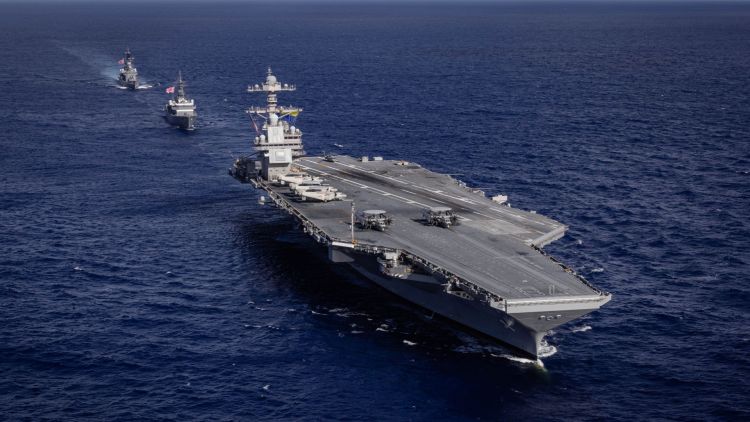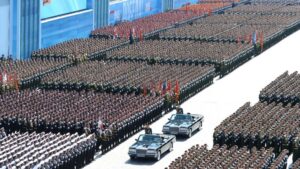Aircraft carriers are the behemoths of the sea, projecting power, influence, and defense for the nations that operate them. These massive floating airbases allow countries to extend their military reach, providing a platform for launching fighter jets, helicopters, and other aircraft.
In this article, we’ll take a look at the current top 7 biggest aircraft carriers in the world, ranked by their length and displacement.
From the cutting-edge USS Gerald R Ford to China’s rapidly expanding fleet, each of these giants has its own unique story, technical specifications, and strategic importance.
1 | USS Gerald R Ford Class (US Navy)
The USS Gerald R. Ford (CVN-78) is the lead ship of the Ford-class carriers and represents the latest in American naval innovation. Commissioned in 2017, it’s the first of its class to replace the aging Nimitz-class carriers.
The ship was named after the 38th President of the United States and is part of the Navy’s goal to maintain unmatched naval superiority.
Displacing a staggering 100,000 tonnes, the Gerald R. Ford is the largest and most advanced aircraft carrier in the world. It’s powered by two A1B nuclear reactors, which generate enough electricity to power 250,000 homes.
The carrier is capable of carrying over 75 aircraft, including the F-35C Lightning II, F/A-18E/F Super Hornet, and the E-2D Advanced Hawkeye.
Upgrades and Innovations: The Gerald R. Ford class features several technological upgrades, including the Electromagnetic Aircraft Launch System (EMALS), which replaces the traditional steam catapult. This allows for smoother, more efficient aircraft launches.
Other notable improvements include advanced radar systems, enhanced self-defense capabilities, and improved operational efficiency, reducing the crew size compared to Nimitz-class carriers.
Current Role: The Gerald R. Ford is a critical part of US military strategy, allowing the Navy to project power across the globe. Its state-of-the-art systems make it more efficient, increasing sortie rates by up to 33 percent compared to older carriers. It is poised to serve as the backbone of US naval operations well into the 21st century.
2 | Nimitz Class (US Navy)
The Nimitz class, introduced in the 1970s, has been the workhorse of the US Navy for decades. Named after World War II Admiral Chester W. Nimitz, these carriers were designed to serve as the centerpiece of the Navy’s fleet.
The revered aircraft carriers initially had a displacement of around 97,000 tonnes, but as these vessels have been upgraded and loaded with more advanced equipment over time, their full load displacement has surpassed 100,000 tonnes.
For example, the USS Abraham Lincoln (CVN-72) now displaces 104,112 long tons (105,783 metric tonnes) at full load. This makes them some of the heaviest military vessels ever constructed.
Each ship in the class is powered by two Westinghouse A4W nuclear reactors, giving them an operational lifespan of about 20-25 years before requiring refueling. The ships can travel over 30 knots and operate for extended periods without needing to dock.
Upgrades and Innovations: While older than the Ford-class, the Nimitz-class carriers have undergone continuous upgrades over the years. These include modernized radar systems, missile defense capabilities, and improved flight deck technologies.
These ships can carry around 70-80 aircraft and have been equipped to handle the latest fighter jets like the F-35C.
Current Role: Although newer carriers like the Gerald R. Ford are entering service, the Nimitz-class remains a vital part of US naval power. They continue to be deployed worldwide, supporting US military operations and showing the flag in strategic regions such as the South China Sea and the Middle East.
3 | Fujian (China)
China’s Fujian (Type 003) is the largest and most advanced aircraft carrier in the People’s Liberation Army Navy (PLAN) fleet. Named after the Fujian province, the carrier was launched in 2022 and represents a significant leap forward for China’s naval capabilities.
Displacing around 80,000 tonnes, the Fujian is China’s first domestically-built carrier to feature a fully integrated catapult launch system, much like the EMALS found on the Ford-class. The Fujian is powered by conventional steam turbines and can carry about 40 aircraft, including J-15 fighters and early warning aircraft.
Upgrades and Innovations: The Fujian marks a shift for China from the ski-jump launch system used on its earlier carriers to an electromagnetic catapult system, allowing for quicker and more efficient aircraft launches.
It also features enhanced radar systems and more advanced aircraft handling capabilities, making it a formidable addition to China’s naval power.
Current Role: Still in its early operational stages, the Fujian is expected to become a key element of China’s expanding naval presence in the Pacific and Indian Oceans.
As China seeks to challenge US dominance in the region, the Fujian will play a central role in its power projection strategy.
4 | Shandong (China)
Launched in 2017, the Shandong (Type 002) is China’s first domestically-built aircraft carrier. It is based on the Soviet-designed Liaoning and represents a significant milestone in China’s efforts to develop a world-class navy.
With a displacement of 70,000 tonnes, the Shandong uses a ski-jump takeoff system and is powered by conventional engines. The ship can carry around 36 J-15 fighter jets and several helicopters, making it smaller than its American counterparts but still a considerable force.
Upgrades and Innovations: Though lacking the catapult system found on the Fujian, the Shandong has benefited from upgrades in radar and electronic warfare systems. It is also equipped with advanced missile defense capabilities, giving it the ability to defend itself against potential threats.
Current Role: The Shandong is primarily focused on China’s interests in the South China Sea and is often seen as a symbol of China’s growing naval ambitions. It’s expected to serve as a platform for both combat and humanitarian missions in the region.
5 | Queen Elizabeth Class (Royal Navy)
The Queen Elizabeth-class carriers are the largest ships ever built for the Royal Navy. The lead ship, HMS Queen Elizabeth, was commissioned in 2017, followed by its sister ship, HMS Prince of Wales, in 2019.
With a displacement of 65,000 tonnes, these carriers feature a unique twin-island design, one for navigation and the other for flight operations.
They are conventionally powered and can carry up to 40 aircraft, including F-35B Lightning II fighter jets.
Upgrades and Innovations: The Queen Elizabeth class is equipped with the latest in stealth and radar-evading technology. Unlike US carriers, these ships use a ski-jump ramp for launching aircraft. They are also designed to operate with a smaller crew, making them more efficient in terms of manpower.
Current Role: These carriers represent the United Kingdom’s return to carrier strike operations, projecting British naval power across the globe.
HMS Queen Elizabeth has already conducted operations in the Indo-Pacific, signaling the UK’s commitment to global maritime security.
6 | Admiral Kuznetsov (Russia)
Launched in 1985, the Admiral Kuznetsov is Russia’s only aircraft carrier and has had a tumultuous service history. Its development dates back to the Soviet era, and it has been plagued by maintenance issues throughout its life.
With a displacement of 58,500 tonnes, the Admiral Kuznetsov is powered by steam turbines and features a ski-jump ramp for launching aircraft.
It can carry about 30 aircraft, including Su-33 fighters and Ka-52 helicopters.
Upgrades and Innovations: The Admiral Kuznetsov has seen several upgrades over the years, particularly in terms of its weaponry. It is equipped with P-700 Granit anti-ship missiles, making it not just a carrier but a heavily armed warship.
Current Role: Currently undergoing a major refit, the Admiral Kuznetsov has been largely inactive in recent years. Once repairs are complete, it is expected to rejoin the Russian Navy, though its future remains uncertain due to ongoing mechanical issues.
7 | Liaoning (China)
The Liaoning is a former Soviet carrier that China purchased from Ukraine in 1998. After extensive refurbishments, it was commissioned into the People’s Liberation Army Navy in 2012 as China’s first aircraft carrier.
With a displacement of 58,000 tonnes, the Liaoning uses a ski-jump ramp for launching aircraft. It can carry around 24 J-15 fighter jets and various helicopters.
Upgrades and Innovations: The Liaoning has received continuous upgrades since its commissioning, including enhanced radar systems and improved combat capabilities.
While not as advanced as China’s newer carriers, it serves as a vital training platform for PLAN pilots.
Current Role: The Liaoning is primarily used for training purposes, helping to develop China’s naval aviation capabilities. However, it has also been deployed in the South China Sea as part of China’s ongoing efforts to assert its territorial claims.
Sailing Into the Future: The Power of Giants
Aircraft carriers are critical assets for any nation that wants to safeguard its maritime rights and project power globally. With 41 active aircraft carriers in service across 13 navies worldwide, these vessels play a pivotal role in modern naval strategy.
The US Navy leads the pack with 11 carriers, while China and the United Kingdom operate three and two, respectively. Countries like India, France, Russia, and Italy currently have one carrier each, with India commissioning its first homemade carrier in 2022.
Additionally, nations such as Japan, France, Australia, Egypt, Brazil, South Korea, and Thailand operate a combined 14 smaller carriers designed for helicopters, further demonstrating the global race to enhance naval capabilities.
As technology advances and more countries build or upgrade their fleets, these massive ships will continue to be a dominant force on the world’s oceans, shaping the future of naval warfare and global influence.
—
Disclaimer: SOFREP utilizes AI for image generation and article research. Occasionally, it’s like handing a chimpanzee the keys to your liquor cabinet. It’s not always perfect and if a mistake is made, we own up to it full stop. In a world where information comes at us in tidal waves, it is an important tool that helps us sift through the brass for live rounds.



